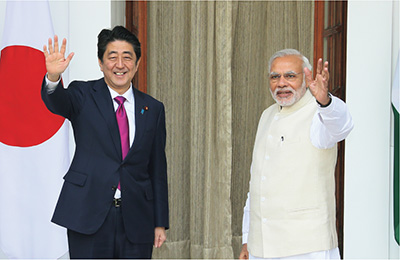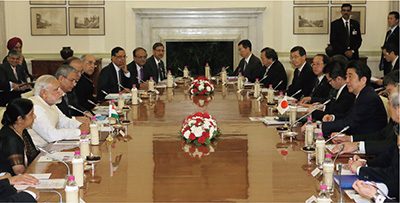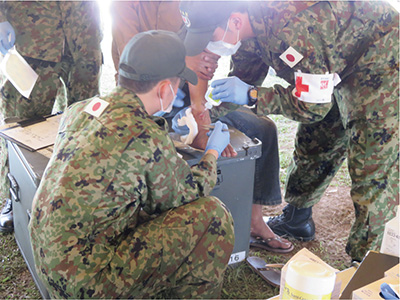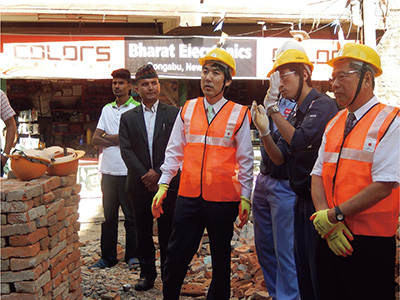Diplomatic Bluebook 2016
Chapter 2
Japan’s Foreign Policy that Takes a Panoramic Perspective of the World Map
4.South Asia
(1) India
India is situated in between Southeast Asia and the Middle East, as well as in the center of the Eurasian continent. Thus the country lies in a geopolitically important region. India is also characterized as an emerging economic superpower, being the 3rd largest economy in Asia, with a huge market embracing the world’s 2nd largest population and a huge domestic infrastructure demand. Furthermore, India is the world’s largest democratic country, and shares common universal values with Japan, such as democracy and the rule of law.
The country has been maintaining a high economic growth rate around the 7% mark since Prime Minister Modi took office in May 2014. Consumption and production have been improving in addition to stock prices rising, and the foreign direct investment and finance emphasized by the Modi administration has been increasing steadily as well.
 Prime Minister Abe receiving a welcome from Prime Minister Modi (December 12, New Delhi, India; Photo: Cabinet Public Relations Office)
Prime Minister Abe receiving a welcome from Prime Minister Modi (December 12, New Delhi, India; Photo: Cabinet Public Relations Office) Japan-India summit meeting (December 12, New Delhi, India; Photo: Cabinet Public Relations Office)
Japan-India summit meeting (December 12, New Delhi, India; Photo: Cabinet Public Relations Office)In diplomatic relations, Prime Minister Modi has stepped up leader-level exchanges to strengthen relations with South Asian region and ASEAN members. He also has set the “Act East” policy with an emphasis on the relationship with East Asia and Southeast Asia. Furthermore, he has actively been meeting with the leaders of major countries including Japan, the United States, China and EU member states, thereby having India gain more influence in the international arena as a global power.
In the relationship with Japan, summit meetings took place in November, on the occasions of international conferences held in Kuala Lumpur and Paris. In December, Prime Minister Abe visited India, and a joint statement serving as a signpost for a “new Japan-India era” was announced, entitled “Japan-India vision 2025: Special strategic and global partnership-Cooperation for the peace and prosperity in the India Pacific area and the world.” The summit meeting came up with concrete results for further strengthening cooperative relations between Japan and India in various fields, such as politics and security, economic affairs and cooperation, people-to-people exchange and regional and global issues, and confirmed the beginning of a “new era in Japan-India relations.” In the field of politics and security, the two leaders agreed on a Japan-India nuclear cooperation agreement in principle, and signed a Defense Equipment and Technology Transfer Agreement and an Agreement concerning Security Measures for the Protection of Classifieds Military Information. In the economic field, they confirmed a plan to introduce the Shinkansen system into a high-speed railway between Mumbai and Ahmedabad, and announced the establishment of a framework for providing a financial facility of 1.5 trillion yen to Japanese companies operating in India through the Nippon Export and Investment Insurance (NEXI) and Japan Bank for International Cooperation (JBIC) to boost their business opportunities. During his visit, Prime Minister Abe visited Varanasi with Prime Minister Modi to see a religious ceremony in the Ganges.
Furthermore, a foreign ministers’ strategy dialogue between Japan and India took place in January, and a Japan-U.S.-India foreign ministers’ meeting took place in September for the first time to deepen the strategic partnership among the three countries.
(2) Pakistan
Pakistan is situated in a strategic location connecting Asia and the Middle East. Thus its political stability and economic development has significant meaning for the region, having great influence on the regional stability and growth. Pakistan has also become the most important country for international counter-terrorism measures. Furthermore, the country embraces a population of approximately 180 million. Thus its economic potential is high. Prime Minister Sharif has been addressing economic and fiscal reform and security improvements including counter-terrorism as the most important issues. Effects of the policy are gradually appearing.
In security, the Pakistani military has been continuing its operations against the armed forces including the Tehrik-i-Taliban Pakistan (TTP) since June 2014. Although there occurred retaliatory terrorism incidents by the TTP in 2014, the number of such incidents was greatly reduced in 2015.
In foreign affairs, some moves on the relationships with neighboring countries were observed. The relationship with India has cooled down since the summer of 2014, caused by the intensification of cross-border attacks by both Indian and Pakistan armies in Kashmir. While a full-fledged dialogue has not been resumed yet, a summit meeting between the two countries was held in Russia in July 2015, and it is also confirmed that Prime Minister Modi will participate in a South Asia Association for Regional Cooperation (SAARC) Summit to be held in Pakistan in 2016. In addition, on the occasion of the 21st session of the Conference of Parties to the UN Framework Convention on Climate Change(COP21)held in November, a standing conversation between the leaders took place. Then, on his return home from a visit to Afghanistan in December, Prime Minister Modi paid a surprise visit to Pakistan and had a short meeting with Prime Minister Sharif. In this way, a certain move can be seen toward improved relations. The relationship with China has been further enhanced in a wide range of fields. When President Xi Jinping visited Pakistan in April, the bilateral relationship was upgraded to an “all-weather strategic cooperative partnership,” and as a first phase to build an economic corridor bet-ween China and Pakistan serving as a bridge of the “One belt, one road” being promoted by China, a launch of projects amounting to 2.8 billion US dollars was determined. In the relationship with Afghanistan, the Government of Pakistan served as mediator for a reconciliation process with the Taliban in July, but the dialogue has not progressed since then.
On the economic front, structural reforms have been carried out under the IMF program since September 2013. Foreign direct investment is on the decrease, but macroeconomic indicators have been generally improving, including foreign exchange reserves and a continued growth rate around the 4% mark.
In the relationship with Japan, on the occasion of the Asia-Europe Meeting (ASEM) Foreign Ministers’ Meeting (in Luxembourg) held in November, a foreign ministers’ meeting between Foreign Minister Kishida and Advisor to the Prime Minister in charge of foreign affairs Aziz was held, the first such meeting after the Sharif administration was inaugurated, and the Government Business Joint Dialogue was also organized in Islamabad in November for the first time in three years, attended by 24 Japanese companies.
(3) Bangladesh
Bangladesh, in which Muslims account for about 90% of the population, is a democratic country located in the Bay of Bengal, and is geopolitically very important as an intersection between India and ASEAN.
In internal affairs, the security situation became worse for a period from January to March as the confrontation between the ruling and opposition parties intensified resulting in more than 100 death. The murder of an Italian occurred in September, followed by the murder of a Japanese in October. In addition, a series of terrorism incidents targeting Muslim and Hindu religious facilities and security officials and attacks against secular writers and bloggers occurred.
The country, though classified as a least developed country, maintains a steady economic growth rate of about 6%, attributed to robust exports such as textile products. Bangladesh embraces a population of about 160 million people, attracting attention as a potential market combined with production bases with an abundant, inexpensive and high-quality labor force available and considerable infrastructure demand. The number of Japanese-affiliated companies doing business in the country has increased from 61 (2005) to 238 (December 2015). On the other hand, remittances from overseas emigrants and migrant workers serve as an important means for foreign currency acquisition, accounting for nearly 10% of nominal GDP. The stable supply of electric power and natural gas and infrastructure development has also become an issue for investment by foreign companies.
In the relationship with Japan, high-ranking Bangladesh government officials visited Japan one after another, and on the occasions of Asian-African Conference 60th anniversary summit held in April (in Indonesia) and UN General Assembly held in September, Prime Minister Abe and Prime Minister Hasina conducted summit meetings and confirmed close cooperation under the “Comprehensive Partnership,” launched through mutual visits by the two leaders in the previous year.
(4) Sri Lanka
Sri Lanka is situated in a strategic point on the sea lanes in the Indian Ocean. The country is traditionally pro-Japanese and its geopolitical and economic importance is attracting attention. After the end of the civil war in 20091, the security situation has greatly improved. Japanese tourists quadrupled approximately as compared with 2008 to about 40,000 (2014).
In domestic affairs, Sirisena, a joint candidate of the opposition parties beat President Rajapaksa at the presidential election in January 2015, and was appointed as the new president. At the general election carried out in August, the United National Party (UNP) and the Sri Lanka Freedom Party (SLFP) formed a grand coalition, and the leader of the UNP, Wickremesinghe, was re-elected as prime minister.
The new administration set up a National Reconciliation Bureau toward national reconciliation, an important issue after the end of the civil war, and has been working on the promotion of the issue in a variety of ways, including showing the intention to install a mechanism consisting of 4-layer systems to correspond to investigation of the truth related to alleged human rights violations, rights for justice, rights for compensation and prevention of recurrence of conflict.
The economy of Sri Lanka has been growing at 6% or above annually in recent years, and its per-capita GDP was recorded at 3,609 US dollars in 2014. Given the geopolitical importance of the country and its access to the Indian market, even higher growth is expected.
In the relationship with Japan, Prime Minister Wickremesinghe visited Japan to meet with Prime Minister Abe in October, and a “Joint Declaration on Japan-Sri Lanka comprehensive partnership” was announced. In this Declaration, it was confirmed that the two countries would facilitate cooperation for investment and trade promotion and national development plan, and implementation of initiatives for national reconciliation and peace building.
- 1 In Sri Lanka, the LTTE, an anti-government armed force composed of minority Tamil people living mainly in the north and east of Sri Lanka was in a state of civil war with the government for more than 25 years from 1983 to 2009, aiming at the separation and independence of the northern and eastern part of the country.
(5) Nepal
Nepal has geopolitical importance as a landlocked country sandwiched between the great powers of China and India. Japan has for many years been a major donor to Nepal, and the two countries keep traditionally friendly relations through a variety of exchanges including relations between the imperial family and the former royal family, and mountaineering.
The big earthquake that occurred in the central western area of Nepal on April 25 caused serious damage, including nearly 9,000 deaths and injured totaling more than 20,000. Japan, as emergency humanitarian assistance, implemented dispatch of an international emergency assistance mission comprising of rescue teams, medical teams and Self-Defense Force teams (medical assistance corps), provision of emergency relief goods, and an emergency grant aid of 14 million US dollars (about 1,680 million yen). Furthermore, at the International Conference on Nepal Reconstruction (in Kathmandu) held on June 25, Japan expressed as its recovery and reconstruction assistance the implementation of support totaling 260 million US dollars (over 320 billion yen) with an emphasis on reconstruction of houses, schools and public infrastructure, as well as support for Nepal’s efforts toward better recovery from the earthquake disaster.
In domestic affairs, the country has been consistently making efforts for enacting a new Constitution since the Constituent Assembly opened in 2008, in response to the comprehensive peace agreement in 2006. The enactment process had gone through difficulties caused by the confrontation among major political parties. The big earthquake occurring in April 2015, however, accelerated a move toward enactment since the enactment was thought to be critical to recover from the earthquake disaster. In this way, a new Constitution reorganizing Nepal into a secular state of federalism was promulgated in September 2015. In October, pursuant to the provisions of the new Constitution, President Oli of the Communist Party of Nepal (Unified Marxist-Leninist) (CPN-UML) was elected as the new prime minister, and a coalition government including the CPN-UML was established.
 Medical activities by Self-Defense Force troops
Medical activities by Self-Defense Force troops State Minister for Foreign Affairs Kiuchi visiting the disaster site of the earthquake in Nepal (June, Kathmandu, Nepal)
State Minister for Foreign Affairs Kiuchi visiting the disaster site of the earthquake in Nepal (June, Kathmandu, Nepal)As regards the relationship with Japan, a Japan-Nepal foreign ministers’ meeting was held in March 2015, followed by a Japan-Nepal Political Dialogue between the Ministries of Foreign Affairs (in Tokyo) in the same month, through which bilateral cooperation, including policy areas has been expanding.
(6) Bhutan
Bhutan shifted peacefully from a monarchy to a constitutional monarchy in 2008. Currently, efforts are being made to establish democratization under the Tobgay administration. The government sets Gross National Happiness (GNH) as a guideline for steering the country, and is working on economic independence, food production and reduction of the youth unemployment rate, all of which are issues targeted in the 11th Five-Year Plan (ending in 2018).
As regards the relationship with Japan, His Majesty and Her Majesty of Bhutan visited Japan as state guests in 2011 and, with the visit as an opportunity, exchanges between Japan and Bhutan have been active in a variety of fields and at various levels. In March, Economic Minister Wangchuk visited Japan, and met with State Minister for Foreign Affairs Minoru Kiuchi to exchange views on efforts for establishing democratization in Bhutan and Japan’s support for agriculture and infrastructure sectors.
(7) Maldives
Maldives is an island country in the Indian Ocean, and its economic growth is mainly led by fishing and tourism, which accounts for about 30% of GDP. The country graduated from a least developed country in 2011, and increased its per-capita GDP to about 8,484 US dollars (2014).
In domestic affairs, the security situation is seen to have temporarily entered into a phase of destabilization, as evidenced by the bombing on a boat the president was aboard, which occurred in September, and a state of emergency declared in early November2.
As regards the relationship with Japan, momentum to strengthen bilateral ties is growing, including the Embassy of Japan in the Maldives opening in January 2016. Mutual VIP visits have been active between the two countries. In July 2015, Parliamentary Vice-Minister for Foreign Affairs Nakane attended the ceremony commemorating the 50th anniversary of independence held in Male, Maldives, whereas Foreign Minister Maumun visited Japan to participate in the “WAW! 2015,” an international women’s conference in August. At the Japan-Maldives foreign ministers’ meeting held on this occasion, they agreed to strengthen dialogue and cooperation between the two countries in the fields of marine and climate change.
- 2 On November 4, President Yamin of the Maldives issued a state of emergency declaration on the grounds of the existence of a “threat to national and social safety”. On November 10, the emergency declaration was lifted since there was no longer a threat to the public.
